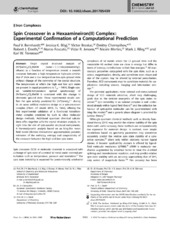| dc.contributor.author | Bernhardt, Paul V. | |
| dc.contributor.author | Bilyj, Jessica K. | |
| dc.contributor.author | Brosius, Victor | |
| dc.contributor.author | Chernyshov, Dmitry | |
| dc.contributor.author | Deeth, Robert J. | |
| dc.contributor.author | Foscato, Marco | |
| dc.contributor.author | Jensen, Vidar Remi | |
| dc.contributor.author | Mertes, Nicole | |
| dc.contributor.author | Riley, Mark J. | |
| dc.contributor.author | Törnroos, Karl Wilhelm | |
| dc.date.accessioned | 2020-06-12T16:34:39Z | |
| dc.date.available | 2020-06-12T16:34:39Z | |
| dc.date.issued | 2018-01-06 | |
| dc.Published | Bernhardt P, Bilyj JK, Brosius V, Chernyshov D, Deeth RJ, Foscato M, Jensen VR, Mertes N, Riley M, Törnroos KW. Spin Crossover in a Hexaamineiron(II) Complex: Experimental Confirmation of a Computational Prediction. Chemistry - A European Journal. 2018;24(20):5082-5085 | eng |
| dc.identifier.issn | 0947-6539 | en_US |
| dc.identifier.issn | 1521-3765 | en_US |
| dc.identifier.uri | https://hdl.handle.net/1956/22572 | |
| dc.description.abstract | Single crystal structural analysis of [Fe^II(tame)_2]Cl_2⋅MeOH (tame=1,1,1‐tris(aminomethyl)ethane) as a function of temperature reveals a smooth crossover between a high temperature high‐spin octahedral d^6 state and a low temperature low‐spin ground state without change of the symmetry of the crystal structure. The temperature at which the high and low spin states are present in equal proportions is T_1/2=140 K. Single crystal, variable‐temperature optical spectroscopy of [Fe^II(tame)_2]Cl_2⋅MeOH is consistent with this change in electronic ground state. These experimental results confirm the spin activity predicted for [Fe^II(tame)_2]^2+ during its de novo artificial evolution design as a spin‐crossover complex [Chem. Inf. Model . 2015 , 55 , 1844], offering the first experimental validation of a functional transition‐metal complex predicted by such in silico molecular design methods. Additional quantum chemical calculations offer, together with the crystal structure analysis, insight into the role of spin‐passive structural components. A thermodynamic analysis based on an Ising‐like mean field model (Slichter–Drickammer approximation) provides estimates of the enthalpy, entropy and cooperativity of the crossover between the high and low spin states. | en_US |
| dc.language.iso | eng | eng |
| dc.publisher | Wiley | en_US |
| dc.rights | Attribution CC BY | eng |
| dc.rights.uri | http://creativecommons.org/licenses/by/4.0/ | eng |
| dc.subject | amines | eng |
| dc.subject | density functional calculations | eng |
| dc.subject | iron | eng |
| dc.subject | optical spectroscopy | eng |
| dc.subject | spin crossover | eng |
| dc.title | Spin Crossover in a Hexaamineiron(II) Complex: Experimental Confirmation of a Computational Prediction | en_US |
| dc.type | Peer reviewed | |
| dc.type | Journal article | |
| dc.date.updated | 2020-01-31T09:56:44Z | |
| dc.description.version | publishedVersion | en_US |
| dc.rights.holder | Copyright 2018 The Author(s) | en_US |
| dc.identifier.doi | https://doi.org/10.1002/chem.201705439 | |
| dc.identifier.cristin | 1613523 | |
| dc.source.journal | Chemistry - A European Journal | |
| dc.relation.project | Notur/NorStore: NS2506K | |
| dc.relation.project | COST (European Cooperation in Science and Technology): CM1305 | |
| dc.relation.project | Norges forskningsråd: 262370 | |
| dc.relation.project | Norges forskningsråd: 205273 | |
| dc.relation.project | Notur/NorStore: NN2506K | |

